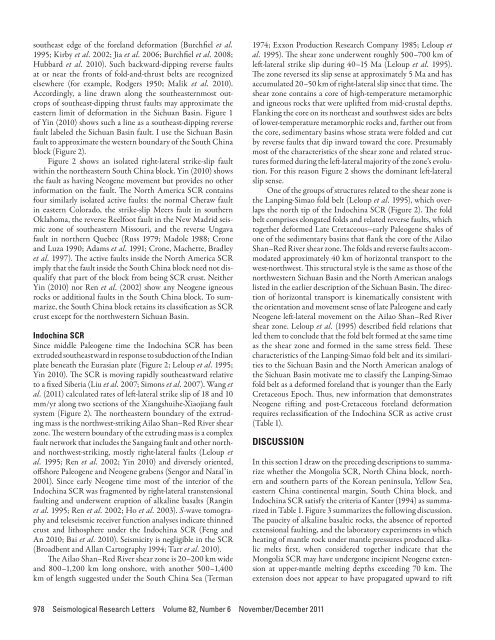Here - Stuff
Here - Stuff
Here - Stuff
Create successful ePaper yourself
Turn your PDF publications into a flip-book with our unique Google optimized e-Paper software.
southeast edge of the foreland deformation (Burchfiel et al.1995; Kirby et al. 2002; Jia et al. 2006; Burchfiel et al. 2008;Hubbard et al. 2010). Such backward-dipping reverse faultsat or near the fronts of fold-and-thrust belts are recognizedelsewhere (for example, Rodgers 1950; Malik et al. 2010).Accordingly, a line drawn along the southeasternmost outcropsof southeast-dipping thrust faults may approximate theeastern limit of deformation in the Sichuan Basin. Figure 1of Yin (2010) shows such a line as a southeast-dipping reversefault labeled the Sichuan Basin fault. I use the Sichuan Basinfault to approximate the western boundary of the South Chinablock (Figure 2).Figure 2 shows an isolated right-lateral strike-slip faultwithin the northeastern South China block. Yin (2010) showsthe fault as having Neogene movement but provides no otherinformation on the fault. The North America SCR containsfour similarly isolated active faults: the normal Cheraw faultin eastern Colorado, the strike-slip Meers fault in southernOklahoma, the reverse Reelfoot fault in the New Madrid seismiczone of southeastern Missouri, and the reverse Ungavafault in northern Quebec (Russ 1979; Madole 1988; Croneand Luza 1990; Adams et al. 1991; Crone, Machette, Bradleyet al. 1997). The active faults inside the North America SCRimply that the fault inside the South China block need not disqualifythat part of the block from being SCR crust. NeitherYin (2010) nor Ren et al. (2002) show any Neogene igneousrocks or additional faults in the South China block. To summarize,the South China block retains its classification as SCRcrust except for the northwestern Sichuan Basin.Indochina SCRSince middle Paleogene time the Indochina SCR has beenextruded southeastward in response to subduction of the Indianplate beneath the Eurasian plate (Figure 2; Leloup et al. 1995;Yin 2010). The SCR is moving rapidly southeastward relativeto a fixed Siberia (Liu et al. 2007; Simons et al. 2007). Wang etal. (2011) calculated rates of left-lateral strike slip of 18 and 10mm/yr along two sections of the Xiangshuihe-Xiaojiang faultsystem (Figure 2). The northeastern boundary of the extrudingmass is the northwest-striking Ailao Shan–Red River shearzone. The western boundary of the extruding mass is a complexfault network that includes the Sangaing fault and other northandnorthwest-striking, mostly right-lateral faults (Leloup etal. 1995; Ren et al. 2002; Yin 2010) and diversely oriented,offshore Paleogene and Neogene grabens (Sengor and Natal’in2001). Since early Neogene time most of the interior of theIndochina SCR was fragmented by right-lateral transtensionalfaulting and underwent eruption of alkaline basalts (Ranginet al. 1995; Ren et al. 2002; Ho et al. 2003). S-wave tomographyand teleseismic receiver function analyses indicate thinnedcrust and lithosphere under the Indochina SCR (Feng andAn 2010; Bai et al. 2010). Seismicity is negligible in the SCR(Broadbent and Allan Cartography 1994; Tarr et al. 2010).The Ailao Shan–Red River shear zone is 20–200 km wideand 800–1,200 km long onshore, with another 500–1,400km of length suggested under the South China Sea (Terman1974; Exxon Production Research Company 1985; Leloup etal. 1995). The shear zone underwent roughly 500–700 km ofleft-lateral strike slip during 40–15 Ma (Leloup et al. 1995).The zone reversed its slip sense at approximately 5 Ma and hasaccumulated 20–50 km of right-lateral slip since that time. Theshear zone contains a core of high-temperature metamorphicand igneous rocks that were uplifted from mid-crustal depths.Flanking the core on its northeast and southwest sides are beltsof lower-temperature metamorphic rocks and, farther out fromthe core, sedimentary basins whose strata were folded and cutby reverse faults that dip inward toward the core. Presumablymost of the characteristics of the shear zone and related structuresformed during the left-lateral majority of the zone’s evolution.For this reason Figure 2 shows the dominant left-lateralslip sense.One of the groups of structures related to the shear zone isthe Lanping-Simao fold belt (Leloup et al. 1995), which overlapsthe north tip of the Indochina SCR (Figure 2). The foldbelt comprises elongated folds and related reverse faults, whichtogether deformed Late Cretaceous–early Paleogene shales ofone of the sedimentary basins that flank the core of the AilaoShan–Red River shear zone. The folds and reverse faults accommodatedapproximately 40 km of horizontal transport to thewest-northwest. This structural style is the same as those of thenorthwestern Sichuan Basin and the North American analogslisted in the earlier description of the Sichuan Basin. The directionof horizontal transport is kinematically consistent withthe orientation and movement sense of late Paleogene and earlyNeogene left-lateral movement on the Ailao Shan–Red Rivershear zone. Leloup et al. (1995) described field relations thatled them to conclude that the fold belt formed at the same timeas the shear zone and formed in the same stress field. Thesecharacteristics of the Lanping-Simao fold belt and its similaritiesto the Sichuan Basin and the North American analogs ofthe Sichuan Basin motivate me to classify the Lanping-Simaofold belt as a deformed foreland that is younger than the EarlyCretaceous Epoch. Thus, new information that demonstratesNeogene rifting and post-Cretaceous foreland deformationrequires reclassification of the Indochina SCR as active crust(Table 1).DISCUSSIONIn this section I draw on the preceding descriptions to summarizewhether the Mongolia SCR, North China block, northernand southern parts of the Korean peninsula, Yellow Sea,eastern China continental margin, South China block, andIndochina SCR satisfy the criteria of Kanter (1994) as summarizedin Table 1. Figure 3 summarizes the following discussion.The paucity of alkaline basaltic rocks, the absence of reportedextensional faulting, and the laboratory experiments in whichheating of mantle rock under mantle pressures produced alkalicmelts first, when considered together indicate that theMongolia SCR may have undergone incipient Neogene extensionat upper-mantle melting depths exceeding 70 km. Theextension does not appear to have propagated upward to rift978 Seismological Research Letters Volume 82, Number 6 November/December 2011
















